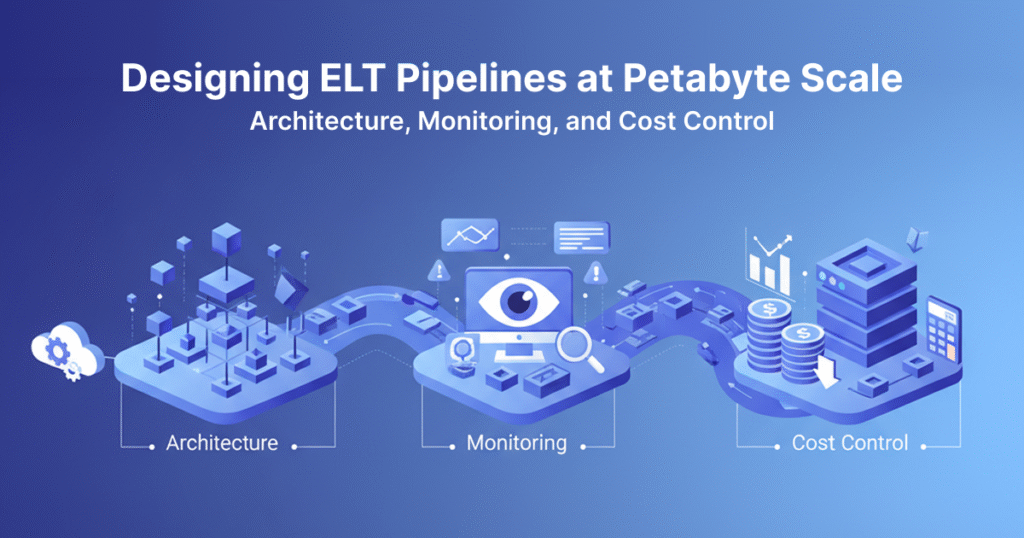If you’ve ever felt like your business is swimming in a virtual ocean of data, you’re not alone. The digital economy in India, from e-commerce giants to fintech startups, generates data at an unprecedented, dizzying rate. We’re talking terabytes, and in many cases, petabytes of information—customer clicks, transaction logs, sensor readings, and much, much more. The real challenge isn’t collecting this data; it’s transforming this vast, raw resource into meaningful, actionable insights without a mountain of complexity and cost.
For a long time, the answer was ETL (Extract, Transform, Load). But with the advent of powerful, scalable cloud data warehouses and lakes, the tables have turned. Today, the modern data professional’s weapon of choice is the ELT Pipeline—Extract, Load, and then Transform. This isn’t just a simple change in the order of operations; it’s a fundamental shift in philosophy that is essential for any business operating at Petabyte Scale. It’s the very foundation of modern Data Architecture.

The ELT Advantage: A New Paradigm for Petabyte Scale
Why has ELT become the preferred method for handling massive datasets? The answer lies in its ability to leverage the immense, distributed compute power of the cloud. In the old world of ETL, transformations happened on a separate, often limited, server before data was loaded into a data warehouse. This was slow, expensive, and inflexible.
With ELT, we do the opposite: we load the raw data directly into a powerful, scalable cloud destination like Snowflake, Google BigQuery, or Amazon Redshift. Then, we transform it within that environment. This approach offers incredible flexibility—you get to keep all your raw data for future analysis and use the cost-effective, near-infinite compute of the cloud to run even the most complex transformations. It’s the perfect match for the unpredictable, massive workloads that come with processing data at Petabyte Scale.
Crafting Your Petabyte-Ready ELT Architecture
A well-designed ELT Pipeline for petabytes of data isn’t a single tool but a sophisticated ecosystem of interconnected components.
First, you have the Extraction layer. This involves connecting to a wide array of sources—be it a legacy Oracle database, a continuous stream from a fleet of IoT sensors, or API feeds from a marketing platform. The key here is high-throughput and reliable data capture.
Next, the Loading phase. This is where we land all that raw, unfiltered data. The unsung hero of this phase is cloud object storage, like Amazon S3 or Google Cloud Storage. They offer a cost-effective, infinitely scalable landing zone for your data, often in open formats like Parquet or ORC, which are perfect for massive-scale analytics. This raw data is then loaded into your data warehouse or data lakehouse, ready for the next step.
Finally, the Transformation layer is where the magic happens. This is where you clean, enrich, and model your data for analysis. The go-to tool for this has become dbt (data build tool), which lets you manage complex, in-warehouse transformations using simple, version-controlled SQL. For more complex, large-scale transformations on data in your lakehouse, tools like Apache Spark are still the gold standard. This multi-layered approach to Data Architecture ensures you have the right tool for the right job, all within a scalable framework.
Mastering Monitoring ELT: Keeping a Pulse on Your Data
Building the pipeline is only half the battle. At petabyte scale, pipelines are like a living organism—they require constant vigilance. Effective Monitoring ELT is non-negotiable and goes far beyond a simple “is it running?” check.
You need to monitor three key areas:
Pipeline Health: Is the data flowing on time? Are jobs succeeding or failing? Are there bottlenecks causing delays? Tools like Apache Airflow or cloud-native orchestrators provide dashboards to track job status and dependencies.
Data Quality: Did a source system change a column name without warning? Is a stream of data suddenly filled with null values? For a petabyte-scale pipeline, you can’t manually check for data quality. Automated checks and anomaly detection are essential to catch issues before they corrupt your downstream reports.
Resource Utilization: This is where things get interesting. At this scale, even small inefficiencies can lead to big costs. You must monitor compute usage, storage I/O, and data transfer costs to ensure you’re not over-provisioning resources.
Taming the Beast: The Art of Cost Optimization
In the world of Cloud Data Pipelines, petabyte-scale ELT can quickly lead to jaw-dropping bills if you’re not careful. Proactive Cost Optimization is not an afterthought; it’s a core engineering practice.
Here’s how modern teams keep costs in check:
Smart Storage Management: Not all data is accessed equally. Use intelligent storage tiers that automatically move less-frequently accessed data to cheaper storage. Employ compression and define clear data retention policies.
Compute Efficiency: Your cloud data warehouse charges you for the compute power you use. Optimize your queries to be as efficient as possible. Leverage auto-scaling features that automatically right-size your clusters based on the workload, ensuring you only pay for what you use. Consider serverless options for jobs with infrequent or unpredictable workloads.
Workload Management: At petabyte scale, multiple jobs can run concurrently and compete for resources. Use workload management features to prioritize critical jobs and prevent resource contention, ensuring your most important reports and dashboards are always up-to-date without a huge spike in costs.
Benefits of Identity-Aware Proxies for Enterprises
Identity-Aware Proxies deliver multiple benefits for modern enterprises. They improve the security posture by reducing unauthorized access and minimizing the risk of data breaches. IAPs simplify the user experience through SSO and MFA, making secure login seamless. They are highly scalable, supporting distributed teams and dynamic cloud workloads without complex VPN infrastructures.
Additionally, IAPs provide centralized visibility and compliance through dashboards for monitoring, reporting, and auditing. This combination of enhanced security, operational efficiency, and usability ensures that enterprises can protect sensitive resources while enabling employees to work without unnecessary friction.
Conclusion: The Future Is Scalable and Optimized
The ability to build and manage robust ELT Pipelines is a non-negotiable skill in today’s data-driven world. At Petabyte Scale, this demands a well-thought-out Data Architecture, a vigilant approach to Monitoring ELT, and a relentless focus on Cost Optimization.
By getting these three pillars right, you can transform your organization from one that simply collects data to one that truly harnesses its power. You can move beyond reactive reporting to proactive, real-time insights that drive smarter decisions and give you a powerful edge in a competitive market. The age of data is here, and the most successful companies are the ones who can handle it at scale, intelligently and efficiently.
Search
Categories

Author
-
Ramesh is a highly adaptable tech professional with 6+ years in IT across testing, development, and cloud architecture. He builds scalable data platforms, automation workflows, and translates client needs into technical designs.Proficient in Python, backend systems, and cloud-native engineering.Hands-on with LLM integrations, stock analytics, WhatsApp bots, and e-commerce apps.Mentors developers and simplifies complex systems through writing and real-world examples.Driven by problem-solving, innovation, and continuous learning in the evolving data landscape.
